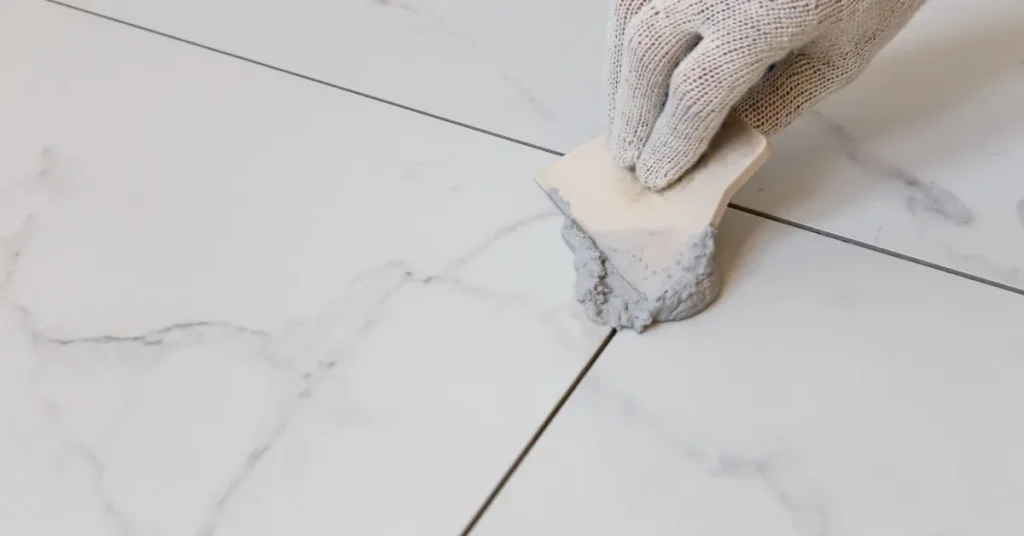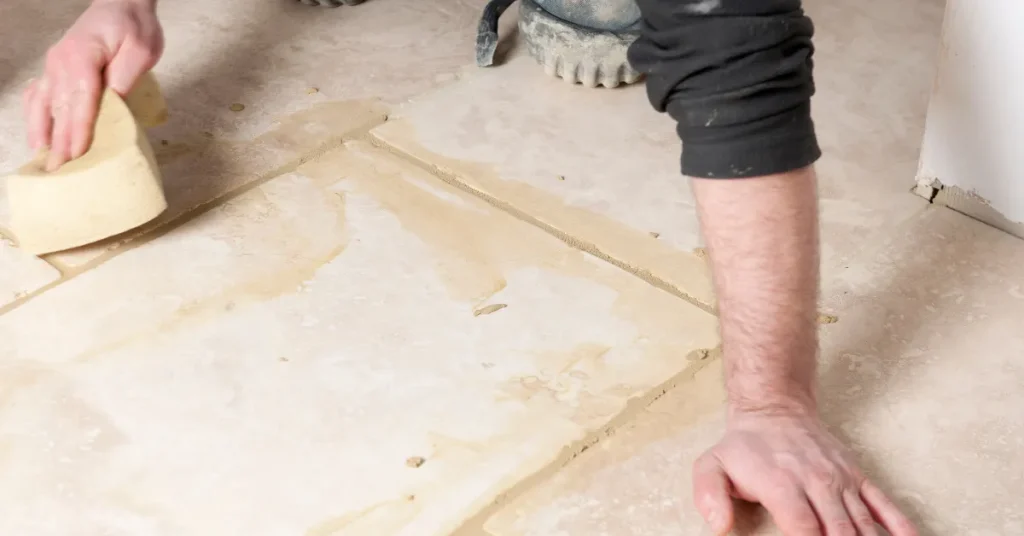Grout thickness typically ranges between 1/16 inch and 1/8 inch for wall tiles. Floor tiles usually require thicker grout lines, approximately 3/16 inch to 1/4 inch.
Selecting the right grout thickness is crucial for the longevity and appearance of your tile installation. This essential component fills the gaps between tiles, keeping moisture out and maintaining the integrity of the surface.
Expert tile installers advise that the size of the grout joint should correlate with the size and type of tile being used.
For instance, larger tiles often necessitate wider grout lines to accommodate slight size variations and to ensure the layout remains visually even.
Conversely, intricate mosaic tiles might only need thin grout lines to preserve the delicate design. Knowing the appropriate grout thickness helps prevent cracking and provides a clean finish, contributing to a professional and aesthetically pleasing project outcome.

The Basics Of Grout Thickness
Understanding the basics of grout thickness is crucial. It ensures your tiling project lasts for years. Here we delve into what you need to know, from types of grout to measurement techniques.
Types Of Grout And Their Typical Thicknesses
Different grout types serve different purposes. The thickness of grout can affect the final look and durability. Let’s explore the common types:
- Unsanded Grout: Best for wall tiles and delicate surfaces. Thickness ranges from 1/16″ to 1/8″.
- Sanded Grout: Ideal for floor tiles where more strength is needed. Normally 1/8″ to 1/2″ thick.
- Epoxy Grout: Highly durable for areas with high moisture. Typical thickness is between 1/16″ and 1/2″.
Measuring Grout Lines For Different Tile Types
Accurate grout line measurement prevents future issues. Each tile type has specific needs:
| Tile Type | Recommended Grout Line Width |
| Ceramic | 1/16″ – 1/4″ |
| Porcelain | 1/8″ – 1/2″ |
| Natural Stone | 1/16″ – 1/2″ |
| Glass Tiles | 1/8″ – 3/16″ |
Using the right spacers when laying tiles ensures uniform grout lines. A rule of thumb: Always double-check specifications for specific tiles.
Choosing The Right Grout For Your Tile
Finding the perfect grout for your tile project plays a crucial role in the finished look of your space. Grout binds tiles together, affects durability, and provides transition between tiles.
Compatibility Between Tile And Grout
Grout selection depends on tile type. Here’s what to consider:
- Ceramic and porcelain tiles: Use sanded or unsanded grout.
- Stone tiles: Unsanded grout is gentler.
- Glass tiles: Require special grout that won’t scratch.
| Tile Type | Grout Type |
| Ceramic/Porcelain | Sanded/Unsanded |
| Stone | Unsanded |
| Glass | Special Non-Scratch |
Impact Of Grout Thickness On Aesthetics
The thickness of grout can alter a room’s look.
- Thin grout lines: Create a seamless appearance.
- Thick grout lines: Emphasize tile shape and pattern.
Choose thin lines for a modern look. Thick lines suit rustic styles.
Influence Of Tile Size On Grout Lines

Grout lines play a vital role in your tile’s appearance and durability.
Tiles of different sizes require specific grout line widths to ensure a seamless look and structural support.
Adjusting Grout Thickness For Large Format Tiles
With large format tiles, precision is key.
Thinner grout lines bring a modern, sleek appearance.
- Grout lines for large tiles usually range from 1/16 to 1/8 inches.
- Wide enough to accommodate slight size differences and tile expansion.
- A leveling system ensures even grout lines and a flat surface.
Grout Line Considerations For Mosaic And Small Tiles
Mosaic tiles create a stunning effect with proper grout lines.
Small tiles often come with mesh backing to keep uniform spacing.
| Tile Size | Recommended Grout Line |
| Under 2 inches | 1/8 inch |
| 1 inch Mosaics | 1/16 inch |
Using the right grout thickness for different tile sizes ensures a beautiful and long-lasting installation.
Professional Tips For Flawless Grout Application
When laying tiles, grout acts like the magic glue that brings harmony to your floors and walls. The right grout thickness ensures a clean, durable finish. Follow professional tips to achieve that perfect look.
The Trowel Technique: Ensuring Consistent Grout Lines
Consistent grout lines are key for a professional finish. Here’s how to use the trowel technique effectively:
- Select the right trowel. Notched trowels help spread grout evenly.
- Hold the trowel at a 45-degree angle.
- Apply pressure to maintain uniform depth and width.
- Consistency is critical. Check often as you go.
Use spacers for even lines and avoid guesswork.
Avoiding Common Mistakes In Grout Thickness
Avoid these pitfalls for a flawless job:
| Mistake | Consequence | Solution |
| Too thin | Weak joints | Follow mix instructions |
| Too thick | Difficult application | Adjust water ratio |
| Inconsistent | Uneven appearance | Use a steady hand |
Measure the mixture carefully. Test the consistency before full application.
Remember, patience is your friend. Take your time to apply grout properly.
Maintaining The Perfect Grout Line

Grout lines play a vital role in tile installation. The right thickness ensures a clean, professional finish.
Ensuring they remain perfect over time requires regular maintenance. This includes proper cleaning and sealing. It also requires understanding how thickness contributes to their longevity and health.
Cleaning And Sealing To Preserve Grout Lines
Clean grout line adds beauty to tiles. Grout collects dirt and grime. Regular cleaning keeps lines perfect. Use gentle, safe cleaners to avoid damage.
- Wipe spills immediately to prevent stains.
- Use a soft brush and mild cleaning solution for routine maintenance.
- Rinse thoroughly with water after cleaning.
Sealing is also key. It protects grout from moisture and stains. Apply a sealer yearly to maintain their appearance.
Long-term Care For Grout: Thickness And Health
Proper grout thickness ensures durability. Thin lines may crack. Thick lines might look uneven. The ideal thickness is about 1/8 inch for most tile installations. Follow these guidelines:
| Type of Tile | Suggested Grout Thickness |
| Wall Tile | 1/16 inch to 1/8 inch |
| Floor Tile | 1/8 inch to 3/16 inch |
Check grout health regularly. Signs of wear or damage mean it’s time to repair. Use matching grout to fill cracks. Keep extra grout from the original batch for minor touch-ups.
FAQs About How Thick Should Grout Be
What Is The Proper Consistency Of Grout?
The proper consistency for grout is similar to peanut butter, ensuring it’s thick enough to hold its shape yet workable. Follow the manufacturer’s instructions for the best results and adjust with water as needed for a smooth, creamy texture that spreads easily.
Should Grout Be Thick Or Thin?
Grout should have a peanut butter-like consistency; not too thick nor too thin. Properly mixed grout spreads easily and holds its shape.
What Is The Standard Thickness Of Grout?
The standard grout thickness for wall tiles is 1/16 to 1/8 inch, and for floor tiles, it’s 1/8 to 1/2 inch.
What Is Proper Grout Depth?
Proper grout depth should equal the thickness of the tile being used. Always ensure grout fills the joint fully to prevent future cracks and damage.
Conclusion
Selecting the proper grout thickness is crucial for both aesthetic appeal and structural integrity. Typically, 1/16 to 1/8 inch suits most tile projects.
Consistency is key to prevent future issues. Remember, the right tools and techniques ensure optimal results. Happy tiling!
Resources:
1. https://www.mass.gov/info-details/grouts
